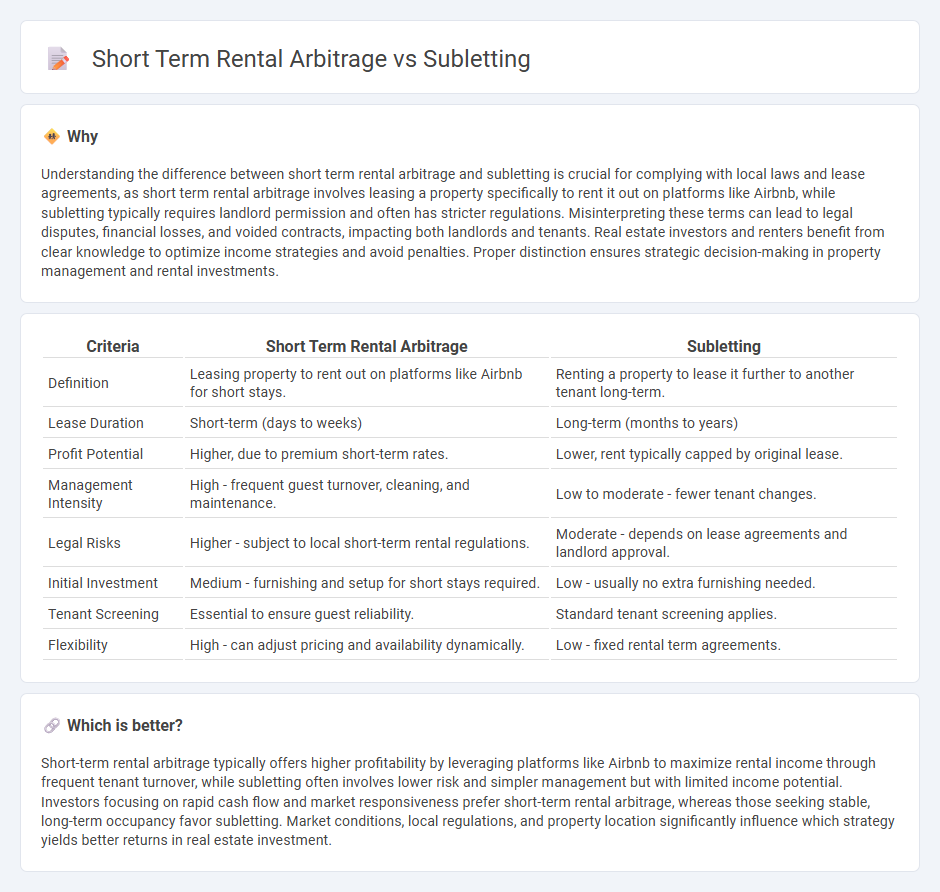
Short term rental arbitrage involves leasing a property with the owner's permission to rent it out on platforms like Airbnb, targeting high turnover and premium pricing. Subletting occurs when a tenant rents out their leased space without explicit consent, often risking lease violations and legal issues. Explore the key differences and strategies to maximize your rental income effectively.
Why it is important
Understanding the difference between short term rental arbitrage and subletting is crucial for complying with local laws and lease agreements, as short term rental arbitrage involves leasing a property specifically to rent it out on platforms like Airbnb, while subletting typically requires landlord permission and often has stricter regulations. Misinterpreting these terms can lead to legal disputes, financial losses, and voided contracts, impacting both landlords and tenants. Real estate investors and renters benefit from clear knowledge to optimize income strategies and avoid penalties. Proper distinction ensures strategic decision-making in property management and rental investments.
Comparison Table
| Criteria | Short Term Rental Arbitrage | Subletting |
|---|---|---|
| Definition | Leasing property to rent out on platforms like Airbnb for short stays. | Renting a property to lease it further to another tenant long-term. |
| Lease Duration | Short-term (days to weeks) | Long-term (months to years) |
| Profit Potential | Higher, due to premium short-term rates. | Lower, rent typically capped by original lease. |
| Management Intensity | High - frequent guest turnover, cleaning, and maintenance. | Low to moderate - fewer tenant changes. |
| Legal Risks | Higher - subject to local short-term rental regulations. | Moderate - depends on lease agreements and landlord approval. |
| Initial Investment | Medium - furnishing and setup for short stays required. | Low - usually no extra furnishing needed. |
| Tenant Screening | Essential to ensure guest reliability. | Standard tenant screening applies. |
| Flexibility | High - can adjust pricing and availability dynamically. | Low - fixed rental term agreements. |
Which is better?
Short-term rental arbitrage typically offers higher profitability by leveraging platforms like Airbnb to maximize rental income through frequent tenant turnover, while subletting often involves lower risk and simpler management but with limited income potential. Investors focusing on rapid cash flow and market responsiveness prefer short-term rental arbitrage, whereas those seeking stable, long-term occupancy favor subletting. Market conditions, local regulations, and property location significantly influence which strategy yields better returns in real estate investment.
Connection
Short term rental arbitrage involves leasing a property and then renting it out on platforms like Airbnb to generate higher returns than traditional leases. Subletting is a key component of this strategy, as it allows tenants to legally rent the leased property to others, maximizing occupancy and profits. Successful arbitrage depends on understanding local regulations and securing landlord permission to avoid legal complications.
Key Terms
Lease Agreement
Lease agreements for subletting typically require explicit landlord consent and often include restrictions regarding tenant rights and property use. Short term rental arbitrage involves leasing a property with the intent to rent it on platforms like Airbnb, demanding comprehensive review of lease terms to ensure compliance with local regulations and landlord policies. Explore our detailed analysis to understand how lease agreements impact your rental strategy and legal obligations.
Occupancy Duration
Subletting typically involves longer occupancy durations, often spanning several months, which provides stability for tenants looking for extended stays. Short-term rental arbitrage targets brief stays, ranging from a few days to weeks, maximizing revenue through frequent tenant turnover. Explore the nuances between these models to determine which best suits your rental strategy.
Profit Margin
Subletting typically yields lower profit margins due to fixed lease agreements and limited pricing control, whereas short-term rental arbitrage leverages dynamic pricing strategies on platforms like Airbnb to maximize revenue. Profit margins in short-term rental arbitrage can exceed 30-50% by capitalizing on high-demand periods and optimizing occupancy rates. Explore detailed strategies to boost your rental income and understand key financial metrics further.
Source and External Links
What is Subletting and How Does it Work? - Neighbor Blog - Subletting means renting out your rented room or apartment to another person (subtenant), while you remain on the original lease and responsible for payments and property care.
All About Subletting - Tenant Resource Center - Subletting adds someone new to an existing lease, usually replacing someone who is moving out, and all lease rules and rental laws still apply to everyone involved.
Subletting - Northeastern University - Network Housing and Relocation - To sublet is to rent your apartment to someone else during your lease term while you stay on the original lease and remain responsible for all lease provisions.
 dowidth.com
dowidth.com